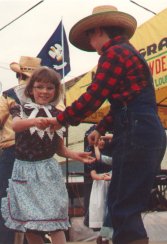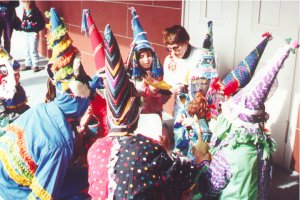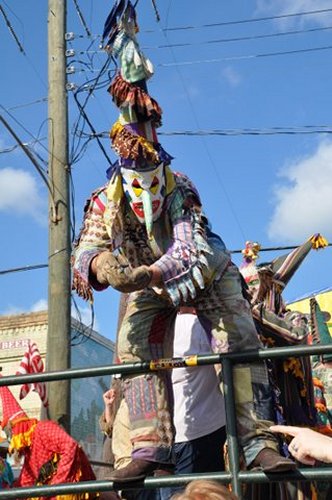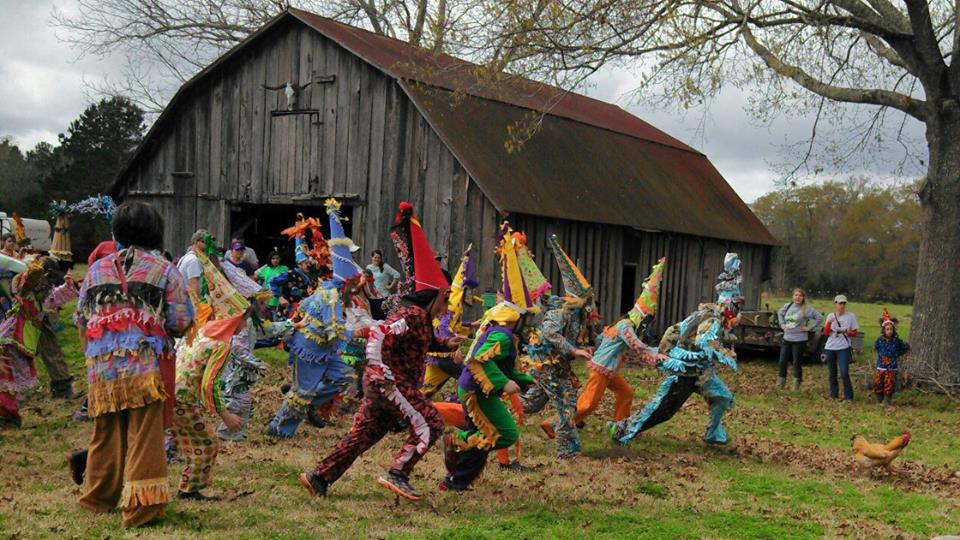More than a dozen south Louisiana prarie Cajun and Creole communities celebrate Fat Tuesday with a traditional courir de Mardi Gras, a day of unbridled festivity before the restraint of Lent.
Many of the customs associated with the Cajun country Mardi Gras can be traced back to ancient European rituals,passed down for generations through many cultures and brought to southwest Louisiana by early French and Acadian settlers. In some communities the Mardi Gras run has been interrupted and later revived by circumstances including World Wars and celebratory rowdiness. It was discontinued altogether in some places earlier in the 20th century.
Like all living traditions, the rural Mardi Gras has changed over time, but the ritual celebration retains much of its old character, symbolism and significance. In communities of Mamou, Eunice, Church Point and others, the day still begins with masked and costumed revelers riding on horseback or in trucks from house to house, begging gifts of food or money in exchange for performances of singing and dancing. As always, it ends with the triumphant return of the Mardi Gras to town and the community gathering to share a day’s bounty in a gros gumbo and dance which ends promptly at Midnight, the beginning of Ash Wednesday.
The Tee Mamou-Iota courir de Mardi Gras is one of few which has survived through the years without a break in continuity. This strong link with tradition and community conviction to its maintenance, combined with local innovation, make the Tee Mamou-Iota run a unique and fascinating event.
Once run on foot and later on horseback, the Tee Mamou-Iota Mardi Gras began to use trucks in the 1940’s.





All who run the Tee Mamou-Iota Mardi Gras must wear traditional handmade costumes and masks. The Mardi Gras suits fashioned of colorful or motley fabric and fringe are topped by the tall, coneshaped hat called a capuchon which dates back to medieval times and symbolizes a mockery of the nobility. Homemade masks, traditionally constructed of wire screen, are creatively elaborated with beards, eyebrows and exaggerated features. In recent years, embroidered plastic mesh has also been employed as an innovation in the art of mask making. The capataine and his co-captains remain undisguised. They maintain discipline among the Mardi Gras and act as the liason between the Mardi Gras and the public. Each captain carries a distinctive whip of braided burlap, which is often used generously to keep unruly Mardi Gras in check.

On the surface, the behaviour of the Mardi Gras often seems to approach chaos. In reality, there is a very strong system of rules which underlies and controls the ritual. All Tee Mamou-Iota Mardi Gras must learn these rules as well as the song at mandatory organizational meetings. Although everyone involved realizes that some rules are meant to be bent, part of being a successful runner is knowing the limits. During the run, Mardi Gras as well as captains moniter each other to ensure that the event does not get out of control.
A good Mardi Gras stretches pre-conceived notions of accepted behaviour to the limit. The runners are not shy about begging, an important feature of the event. The ages-old beggar’s gesture of pointing to an extended cupped palm is frequently seen.